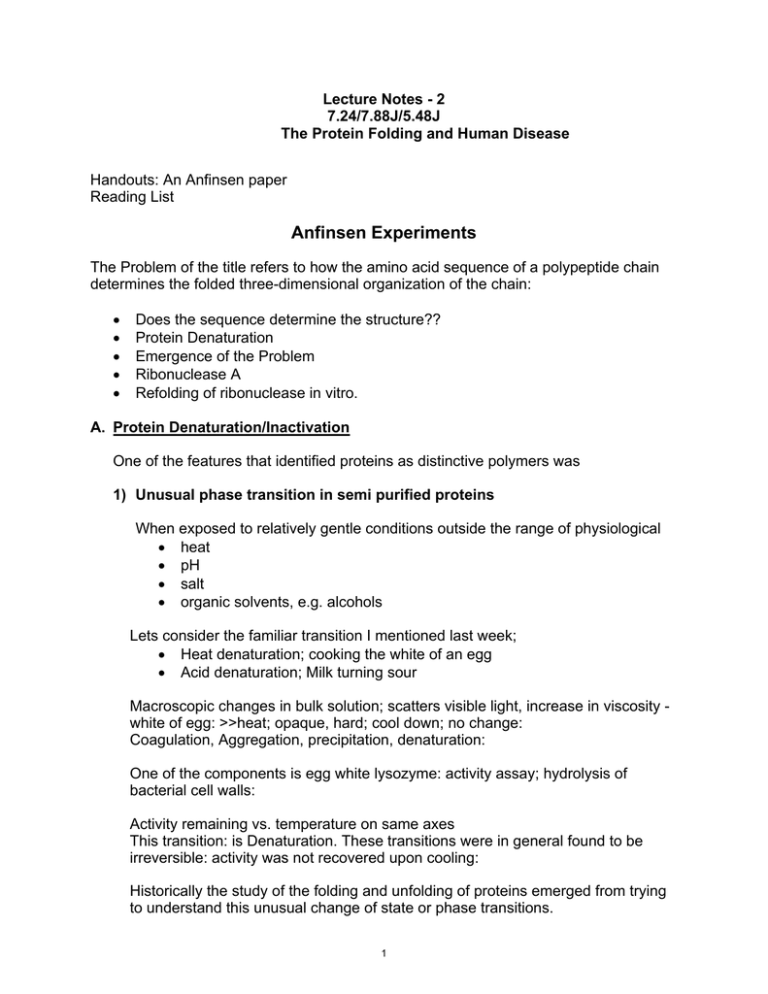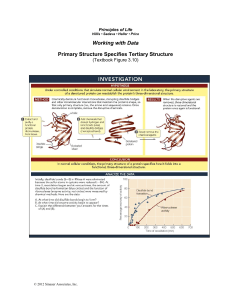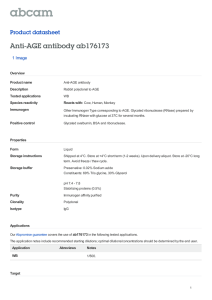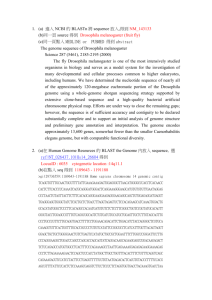Anfinsen Experiments
advertisement

Lecture Notes - 2 7.24/7.88J/5.48J The Protein Folding and Human Disease Handouts: An Anfinsen paper Reading List Anfinsen Experiments The Problem of the title refers to how the amino acid sequence of a polypeptide chain determines the folded three-dimensional organization of the chain: • • • • • Does the sequence determine the structure?? Protein Denaturation Emergence of the Problem Ribonuclease A Refolding of ribonuclease in vitro. A. Protein Denaturation/Inactivation One of the features that identified proteins as distinctive polymers was 1) Unusual phase transition in semi purified proteins When exposed to relatively gentle conditions outside the range of physiological • heat • pH • salt • organic solvents, e.g. alcohols Lets consider the familiar transition I mentioned last week; • Heat denaturation; cooking the white of an egg • Acid denaturation; Milk turning sour Macroscopic changes in bulk solution; scatters visible light, increase in viscosity white of egg: >>heat; opaque, hard; cool down; no change: Coagulation, Aggregation, precipitation, denaturation: One of the components is egg white lysozyme: activity assay; hydrolysis of bacterial cell walls: Activity remaining vs. temperature on same axes This transition: is Denaturation. These transitions were in general found to be irreversible: activity was not recovered upon cooling: Historically the study of the folding and unfolding of proteins emerged from trying to understand this unusual change of state or phase transitions. 1 B. Emergence of the Protein Folding Problem In the period 1958-1960, the first structure of a protein molecule - myoglobin, the oxygen binding protein of muscle - was solved by John Kendrew in 1958, followed soon after by the related tetrameric red blood cell oxygen binding protein, hemoglobin, solved by Max Perutz, both of the British Medical Research Council Labs in Cambridge, U.K. “When the folding of the hemoglobin chain emerged from the model building process, it was shocking. The crystallographers expected each molecule to have high internal symmetry. In fact as Kendrew said, myoglobin is almost nothing but a complicated set of helical rods sometimes going straight for a distance then turning a corner and going off in a new direction;.much more complicated and irregular than most of the early theories of the structure of proteins had suggested.” What’s so surprising; Well like the epicycles every educated person knew that heavenly movements had to be circles; When Kepler showed that orbits were elliptical - a radical departure. Same with proteins; assumed without even being aware, highly regular, formed crystals, diffracted; When it turned out the fold was irregular!!?? Question immediately arises as to how that fold was accurately specified? Since proteins crystallized, many if not all in that fold to high precision. As it became clear that what genes specified was sequence of amino acids, 1) How was fold determined? Emerged as central question in modern biology. Initially, very unclear: • • • • • Since both proteins and DNA helices, perhaps DNA as direct template? Popular, No experimental support emerged. mRNA as template? No physical interaction found. Ribosome as template? Yes, but proteins different from each other, ribosomes the same. Soluble catalysts? Maybe, but most catalysts, proteins, how would their structure be determined? No template!? Mature fold determined by the amino acid sequence directly: The view that 3-D structure is determined by 1-D amino acid sequence, rested for three decades on a series of enormously influential experiments carried out by Christian Anfinsen, Frederick White, Michael Sela, and Edgar Haber at the National Institutes of Health. Behooves us to examine carefully those initial experiments. 2 2) Key Experiments The experimental work that led to an answer was not focused on this question, but even more central scientific question of period, what was the basis of the catalytic power of enzymes? These experiments were carried out with Ribonuclease A from cows. a) Why was NIH team studying Rnase A? One of intense areas of study was mechanism of enzymatic catalysis: Historical context was the effort to understand the mechanism of catalysis of by ribonuclease and to carry out total synthesis. Reactive sulfhydryl groups were prime candidates for participants in active site. Insulin was the first protein whose amino acid sequence was known explicitly; intimately associated with human health problems; But set aside: • • No convenient activity assay: Doesn’t behave according to the accepted dogma: The second protein and first enzyme, was Ribonuclease A. This was isolated from pancreases from slaughterhouses, and assayed by its ability to degrade yeast nucleic acid. For following quarter century, properties of Rnase played dominant role in our image of proteins. Criteria (Biases) for the selection of proteins for characterization: • • • • • • Available in large quantities, cheap, from slaughterhouses; secreted at high concentrations into stomach Stable during purification. Resistant to residual proteases Resistant to chemical and mechanical denaturation Resistant to cold denaturation Very soluble in aqueous buffers - does not aggregate or self-associate Why is it stable? Functions in stomach of cow; evolved to survive in difficult environment, • • in presence of proteases acid pH 3 So not by chance that RNAse was so amenable to purification and characterization evolved property of protein. RNAse was protein used to develop very basic methods of amino acid composition analysis, • • • • • Gel filtration - sephadex and DEAE chromotography, Edman reagent Tryptic mapping many other techniques b) Disulfide Bonds Stanford Moore and William H. Stein “Chemical Structures of Pancreatic Ribonuclease and Deoxyribonuclease” Science, 180, 4 May 1973, 458-464. “The sharing of knowledge among academic scientists and industrial designers of instruments and manufacturers of ion exchangers has played an important role in the progress of biomedical research in this field” Bovine Ribonuclease A: From pancreas and intestines of cows. Major species is Description of Bovine Pancreatic Ribonuclease A: • 124 amino acids. • 13,700 daltons; • 37% beta strand, 23% alpha helix, rest coil 8 cysteines as four disulfides; N--Cys26 - Cys40 – Cys 58 - Cys65 - Cys 72 – Cys84 - Cys 95 - Cys 110 – C00H. 26-84 (between beta strand and helix) 40-95 (between loops connecting beta strands.) 58-110 (helix to strand at the end of sheet) 65-72. (loop to strand) Reactivity of S-S bonds quite heterogenous Quick Review of SH and S-S chemistry: The thiol group of Cys is most reactive of any amino acid side chain. HN – C – S-H C=0 It ionizes at slightly alkaline pH; the thiolate ion is reactive form; For free amino acid pka of 9.0-9.5. In Proteins pk 8.5; 4 but pk very sensitive to local electronic environment, so cannot assume this within proteins. Reacts with very rapidly with alkyl halides such as iodoacetate or iodoacetamide to give stable alkyl thio ether derivatives; Thiols form a variety of complexes with metal ions, Organic mercurials such as para chloro mercuri benzoate. Reaction with latter can be detected by spectral changes; former by incorporation of radioactive amino acids. Cl- with Hg+. make heavy atom derivatives for crystallography. Change in absorption max allows easy quantitation. Sulfur atom is also susceptible to oxidation by oxygen in a reaction that is probably catalyzed by trace heavy metals. End products is CH2 - S - S - Ch2 air or other oxidants, to the sulfoxide: Note that this reaction is multiple step: P-C-S-S--P + S-C-C-OH >>C-S-S-C-C-OH + -S-C -P Mechanism of Catalysis: Are S-S bonds key to catalysis?? In trying to understand the catalytic activity, first question was, does it depend on oxidized S-S bonds? So attempted to prepare fully reduced Rnase: Standard methodlology for S-S Reduction: Purified 4-S-S Rnase + Excess Mercaptoethanol >> Rnase 4 SH reduced, but 2 S-S remained, refractory tp reduction: Then M. Sela, F. H. White Jr, and C. B. Anfinsen (1957) Reductive Cleavage of Disulfide Bridges in Ribonuclease Science, 125, 691-692. Highly Purified RNase: • • • • • - 8M urea, H2N – C (=O) – NH2 0.2 M Beta-mercaptoethanol pH 8.5, 23-24 oC, Purge with Nitrogen 5 • Incubate 4 1/2 hours. Precipitated with acetone in 1M HCl, at -5oC. (Protein denatured, no longer soluble Wash many times with cold ether to remove urea and mercaptoethanol Reaction with PCMB >> e 8 moles of Cysteine. So complelely reduced, pH8.5, ß-mercaptoethanol, This was clear indication that reduction required unfolding! of protein, not just local reduction of S-S bond. They also reported here the first evidence of the recovery of active protein: • • • • Rnase 1mg/ml; 0.01M phosphate, pH7>8 >>>68 hrs with bubbling, room temp >>12-19% recovery of enzymatic activity. "When completely reduced and fully inactivated enzyme (1mg/ml) was subjected to oxidation by air bubbling at room temperature, for 68 hours, 0.01M phosphate, pH7>8, ribonuclease activity reappeared to the extent of circa 12-19% of specific activity" NOT YET CLEAR that this was refolding: The number of SH groups decreased during this process. Still thinking about role of SH groups in active site formation. If they didn't fully reduce, didn't increase the activity upon oxidation! Note, for 8 cysteines, forming 4 bonds, 105 possible pairings: 8!/8C2 # of Cysteines 4 6 8 10 12 # of S-S bonds 2 3 4 5 6 # of combinations 3 15 105 945 10395 Is the re-oxidized material Rnase with native-like activity?? Explicit examination of reoxidation reaction and its product?? Frederick H. White (1961) Regeneration of Native Secondary and Tertiary Structures by Air Oxidation of Reduced Ribonuclease J. Biol. Chem, 236, 1353-1360. Reduction: 20mls at 10mgs/ml 8M with respect to urea and 0.285 M mercaptoethanol at pH 8.5. 6 Purge with nitrogen for 15 minutes [Why??], then >>> incubate in stoppered tube for 4 hrs at room temp. Reduced, inactive, and [presumably, fully unfolded]: Precipitate protein with acetone, on ice: removes urea, mercaptoethanol: For reoxidation, dissolve to 2mgs/ml, add 0.02 M Na2HPO4 adjust to pH8.0 with a few drops of NaOH Oxidize in g250 ml graduated cylinder, with air coming in through tube, 1 bubble/2-5 seconds! Regained active Ribonuclease!! Critical Question: Is refolded material equivalent to starting Rnase?? • • • Reoxidized material shows same ultraviolet 2) absorption spectra – tyrosines and tryps in same environment; chromatographically material similar to starting. Major A peak and minor B peak. Same elution. Same specific activity enzymatically. Are disulfides the same? Carried out digest with proteases Subtilisin and Nagarse>> paper electrophoresis/chromatography. Same S-S peptides spots. UV spectra of reduced has peak slightly shifted from native, presumably because of altered environment disrupts tyrosine OH hydrogen bonds. This reoxidized material was crystallized into two of the well known crystal forms of the proteins. Those crystals diffracting to good resolution and the same lattice constant, indicating the same space group indicating very similar structure}. Characterizing and optimizing reaction conditions and examining dependence on protein concentration: A third series of improvements in the procedures were described by C. B. Anfinsen and Edgar Haber: Studies on the Reduction and Re-formation of Protein Disulfide Bonds J. Biol. Chem, 236, 1361-1363. Careful examination of effects of reaction variables on yield: 7 In order to oxidize, reduced chains have to be separated from reducing agent. Key improvements: • • • Stop reduction reaction by lower pH to 3.5 with glacial acetic acid. After reduction, Isolate reduced chains by column chromotography, rather than acetone precipitation: o Cross-linked dextran sephadex G-25 column equilibrated in 0.1M acetic acid. o To separate reduced protein from residual reducing agent dump thioglycolic acid. Dilute, rather than bubble- denaturation at air/buffer interface? Fraction Number In effort to increase yield of activity, and to decrease insoluble material, Identified three additional experimental variables: • protein concentration; optimal yields at low protein concentrations • thiolation of amino groups by impurities in sulfhydryl agent • inactivation of protein by cyanates generated from urea solution Protocol. Take fractions from column, adjust to PH 8.5 and allow to stand for 20 hours. Table 1. Oxidation of reduced RNase at various protein concentrations Conc. of Red. Prot. 7.0 4.8 2.3 0.9 0.35 % Yield Sol. 27 42 87 100 100 Act of Sol. 31 70 75 77 94 % Recovery 8 29 65 77 94 Activity of soluble is expressed with respect to an equivalent concentration of native RNase. Note that inactive chains must fall into two categories: insoluble and soluble: What do these states represent? What does it mean to have a soluble folded RNAse that is enzymatically inactive? Mispaired disulfides!!? Evidence: Reoxidize in presence of urea!! Reform 4 disulfide bonds, about regain less than 1% of activity. Presumably scrambled ribonuclease. 8 Now yield y optimized, • • • • What are the kinetics of the reaction?? Do in invitro rates account for in vivo rates What are the nature of the intermediates Why is reaction concentration dependent? What is the nature of them - is folded or unfolded species? Reference list Reduction, Denaturation and Refolding of Rnase A In Vitro: Sela, M., F. H. White Jr, and C. B. Anfinsen. “Reductive Cleavage of Disulfide Bridges in Ribonuclease.” Science 125 (1957): 691-692. White, Frederick H. “Regeneration of Native Secondary and Tertiary Structures by Air Oxidation of Reduced Ribonuclease.” J. Biol. Chem 236 (1961): 1353-1360. Anfinsen, C. B., and Edgar Haber. “Studies on the Reduction and Re-formation of Protein Disulfide Bonds.” J. Biol. Chem 236 (1960): 1361-1363. Anfinsen, C. B., E. Haber, M. Sela, and F. H. White Jr. “The Kinetics of Formation of Native Ribonuculease During Oxidation of the Reduced Polypeptide Chain.” PNAS 47 (1961): 1309-1314. Nobel Prize Lectures Anfinsen, C. B. “Principles that Govern the Folding of Protein Chains.” Science 181 (1973): 223-230. Moore, Stanford, and William H. Stein. “Chemical Structures of Pancreatic Ribonuclease and Deoxyribonuclease.” Science 180 (1973): 458-464. 9 MIT OpenCourseWare http://ocw.mit.edu 7.88J / 5.48J / 10.543J Protein Folding and Human Disease Spring 2015 For information about citing these materials or our Terms of Use, visit: http://ocw.mit.edu/terms.







